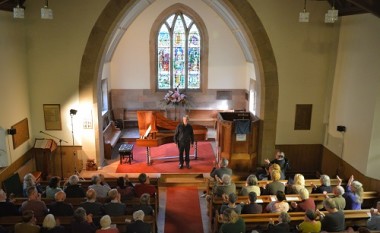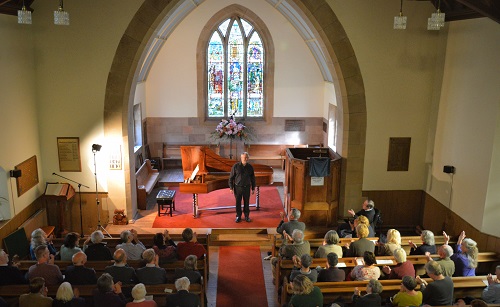
 United Kingdom Lammermuir Festival 2017 – Bach, Howells, Schubert: John Butt (harpsichord), Hebrides Ensemble, Humbie Kirk, Humbie; Hebrides Ensemble, Dirleton Kirk, Dirleton, 16.9.2017. (SRT)
United Kingdom Lammermuir Festival 2017 – Bach, Howells, Schubert: John Butt (harpsichord), Hebrides Ensemble, Humbie Kirk, Humbie; Hebrides Ensemble, Dirleton Kirk, Dirleton, 16.9.2017. (SRT)

Bach – Goldberg Variations, BWV.988
Howells – Rhapsodic Quintet
Schubert – Octet
Every year I manage to make it to the Lammermuir Festival for only a couple of events, but every year I wish I could go to more. This enterprising festival with big ideas looks fairly contained on paper, but has an atmosphere all of its own, where the quality of the music and the performances sits in gems of venues that are mostly very little known.
Set in the rolling landscape of East Lothian, only a few minutes east of Edinburgh, the festival puts on a wide variety of work from symphony concerts to solo recitals with many calling points in between: this year, for example, they’re doing a special screening of Dreyer’s 1928 film La Passion de Jeanne d’Arc accompanied live by the Orlando Consort. They also get top performers from Scotland and beyond: regular collaborators include Steven Osborne, the Dunedin Consort and Tenebrae, and this year the wonderful Quatuor Mosaïques are playing three concerts. Alban Gerhardt and the Gould Piano Trio feature elsewhere, too. The festival’s USP, however, is their use of venues which don’t normally house concerts. These include lots of churches, most obviously the huge St Mary’s in Haddington, but also village halls, a stately home, and even the granary at an 18th century steading.
Thus I found myself at Humbie Kirk, a delightful jewel hidden away in a corner of Scotland I never knew existed before. Set in a secluded glen by a bubbling river (it’s the sort of place that has grass growing down the middle of the road as you drive in), it’s difficult to find, and it certainly isn’t the sort of place you’d automatically associate with one of the world’s leading performers of Bach; yet it was there that John Butt was playing the Goldberg Variations on a harpsichord, and the little church was packed out in consequence.
Butt’s view of the Goldbergs was admirably clear, something he hinted at in his preamble where he spoke a little about the work’s genesis and its view of time (is it cyclical or linear?). In his performance the work generated more momentum and energy as it developed, the second half feeling notably more large-scale than the first. He even cut the gaps between the variations to the minimum towards the end, so as not to break the spell. Thus the ‘Black Pearl’ Variation 25, became the climax of the work, with its aching suspensions and yearning chromaticism standing out in the midst of the lithe, dance-like variations around it. In fact, that spirit of the dance hung over most of the performance, Butt making the whole thing sounding airborne and light, crackling with electricity in places that were often surprising.

I have to confess that I’m not normally a fan of the Goldbergs on a harpsichord – I much prefer the expressivity of a piano, for all its lack of authenticity – so no one was more surprised than I to find myself completely spellbound by the web of sound that Butt was weaving. And this was definitely helped by the atmosphere, something the Lammermuir Festival does uniquely well. The church was packed with a group of modern-day pilgrims who had made the effort and journeyed to a mysterious shrine in the East Lothian hills to hear a master work his magic on us and to revel in the collective shared experience, and as the rain fell outside and the light in the stained glass windows began to darken, I felt an actual shudder of delight in the experience. And that’s something I never thought I’d say about a harpsichord recital!
If the venue was a key part of the recital’s success, then that was also true in terms of size, because Butt’s small instrument could easily have been lost in a bigger auditorium. Another of the festival’s strengths is that they tailor their performers to the performance space, and this worked just as triumphantly when the Hebrides Ensemble played Schubert’s Octet in the seventeenth century Kirk at Dirleton, down on the coast, close to some of Scotland’s premier golfing venues. Dirleton is nearby North Berwick, Edinburgh’s seaside bolt-hole, so at least I’d noticed the signs for it in the past, even if I’d never actually been. The church is a delight, however, fortress-like on the outside but actually very intimate on the inside, with a gorgeous acoustic that the Hebrides Ensemble filled as though it was made for them, the winds sitting on top of a delicious blend of strings, with the clarion-like clarity of the horn as a bonus. Their Schubert Octet was a total treat. The slow introduction was pregnant with expectation, followed by a main allegro that was lithe and full of fun, and the slow movement had an autumnal quality that foreshadowed Brahms, with some delectable wind-playing at the end. The Scherzo became increasingly energetic from what was already a pacey start, and the genial set of variations and warmly romantic Menuet laid the path to a finale that never really shook off the drama of its shuddering introduction.
Preceding that, Howells’ Rhapsodic Quintet is more of a curiosity than an unknown masterpiece. Scored for string quartet plus clarinet, it featured a fraught, tense string sound over which the clarinet sings out a persuasive cantabile line. The sound was sometimes stressed, sometimes intensely lyrical, and the Scherzo-like section in the middle provided a change of mood. The wistful mood was restored at the end but, as so often with Howells, there remain clouds on the horizon, exquisitely evoked by the string players.
So for me this turned out to be a day of musical treats in surprising places. Hard to ask for much more than that, I’d say. The 2017 Lammermuir Festival runs until Sunday 24th September (for information click here). I urge you to check it out.
Simon Thompson
